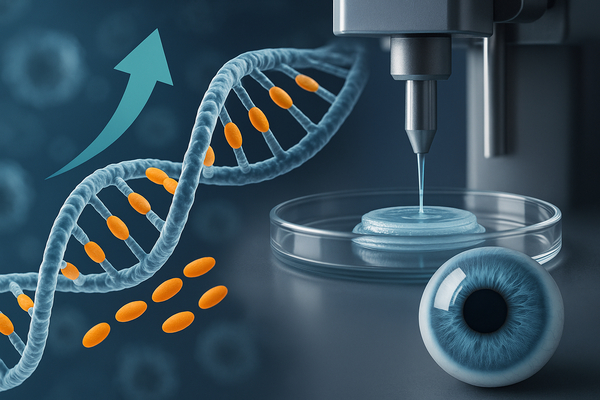
ALS microRNA-126 reversal and a 3D-printed cornea implantation mark two discrete advances in biomedical research that matter now. The ALS finding shows a specific RNA molecule can halt and reverse nerve damage in mice, offering a new therapeutic target while existing drug programs struggle for success. The cornea implant restores sight in a legally blind patient using lab-grown human cells, addressing a chronic donor tissue shortage. Short term, both raise clinical trial activity and investor interest. Long term, they point to gene therapy and tissue engineering scaling across the US, Europe and Israel, with emerging markets likely to benefit from lower-cost, mass-produced biologic implants compared with historical transplant shortages.
Market snapshot: why these stories matter to investors and health systems
Clinical successes reshaping sector priorities
Biotech investors and health systems track breakthroughs that move programs from preclinical stages to trials. The microRNA-126 work and the first 3D-printed cornea are early but visible steps along that path. They arrive while major pharmaceutical players reallocate capital across oncology, metabolic and infectious disease programs. Novo Nordisk (NYSE:NVO) is running high-stakes Alzheimer’s studies tied to GLP-1 drugs. Moderna (NASDAQ:MRNA) has taken a large loan this year and remains a high-profile bio-manufacturer. These moves show big names balancing near-term revenue drivers with longer-term platform bets.
Meanwhile, device and regenerative medicine firms stand to gain focus and funding. Novartis (NYSE:NVS) is expanding manufacturing in North Carolina and creating hundreds of jobs. Pfizer (NYSE:PFE) and Abbott (NYSE:ABT) continue to reshape portfolios with settlements and acquisitions that fund new R&D. That reallocation matters now because venture funding and partnerships respond quickly to clinical signals that suggest scalable technologies.
ALS microRNA-126: a potential new therapeutic lever
From Tel Aviv lab discovery to a clearer target for gene therapy
Researchers led by Eran Perlson at Tel Aviv University reported that microRNA-126 produced by muscle cells prevents accumulation of the toxic protein TDP-43 at neuromuscular junctions. In ALS, muscle production of microRNA-126 falls, the team found. Restoring microRNA-126 in human tissues in vitro and in mouse models reduced toxic protein levels, decreased nerve cell death and allowed damaged nerves to regenerate. The study appeared in Nature Neuroscience and reports both mechanistic detail and functional recovery in experimental models.
Historically, ALS drug development has seen repeated setbacks. Recent late-stage failures from companies developing other approaches have slowed the field. That context makes a new, biologically plausible target notable. The finding does not translate to an approved therapy yet. However, it provides a focused molecular pathway for gene therapy developers and RNA delivery platforms to test in early human trials. Global regulatory interest and academic partnerships will determine how rapidly that occurs.
First 3D-printed cornea implanted in a human
Lab-grown implants aim to overcome donor shortfalls
Surgeons in Israel implanted the first 3D-printed cornea made from human eye cells in a legally blind patient. The implant, called PVEK, is made by Precise Bio, a company with operations in North Carolina and Israel. The technology uses cells from a single donor cornea to generate hundreds of lab-grown implants. That multiplier effect addresses a chronic mismatch between supply and demand for donor tissue.
The procedure is part of a Phase 1 trial that will enroll 10 to 15 patients. Precise Bio expects to report early results by the second half of 2026. If human outcomes prove durable and safety profiles remain acceptable, tissue-engineered corneas could reduce waiting lists in many regions. For health systems, the prospect of mass-produced, cell-based implants changes procurement, surgical training and follow-up care models. For emerging markets, locally produced implants could lower costs compared with import reliance on donor tissue and complex logistics.
Commercial and industry implications
Where funding, partnerships and manufacturing follow clinical signals
Big pharma and biotech are already adjusting priorities based on trial readouts and platform potential. Merck (NYSE:MRK) reported an oral HIV treatment outcome that compares to existing regimens and is exploring AI-driven discovery partnerships. Gilead (NASDAQ:GILD) remains the benchmark for HIV treatment standards. These developments show how late-stage clinical data can shift deal flow and licensing interest.
Manufacturing scale matters for both RNA therapies and tissue-engineered implants. Novartis is adding manufacturing capacity in the US to support biologics scale up. Companies that can deliver reliable cell processing, sterility assurance and reproducible 3D printing workflows will attract partnerships. Contract manufacturing organizations and regional hubs will play a larger role as developers move from proof of concept to regulated clinical production.
Regulatory direction will also shape market timing. Early human trials such as the cornea implant and proposed gene therapy approaches for ALS will generate data regulators use to refine guidance on cell sourcing, gene delivery safety and long-term follow up. That guidance will influence market access strategies across the United States, Europe and Asia. For emerging markets, lower-cost manufacturing and adaptable clinical pathways will determine how quickly new therapies diffuse beyond high-income countries.
Near-term signals and longer-term consequences
What to watch next
Near term, investors and health systems should watch trial enrollment, safety readouts and any partnering announcements from platform technology owners. The timing of Phase 1 readouts for the PVEK cornea implant and preclinical-to-clinical moves for microRNA-126 approaches will be pivotal. In addition, M&A or licensing deals that pair small developers with large manufacturers will indicate commercial conviction.
Long term, success in either domain could shift R&D investment toward RNA therapeutics and tissue engineering. That would reinforce a broader trend where biologics, gene therapies and cell-based implants move from experimental work to standard clinical options. For patients, the promise is new treatment routes for previously intractable conditions and more reliable access to sight-restoring implants. Health systems will need to adapt procurement, reimbursement and training to integrate these technologies responsibly and safely.
Disclosure: This report is informational. It is not financial advice and does not recommend any investment action.












